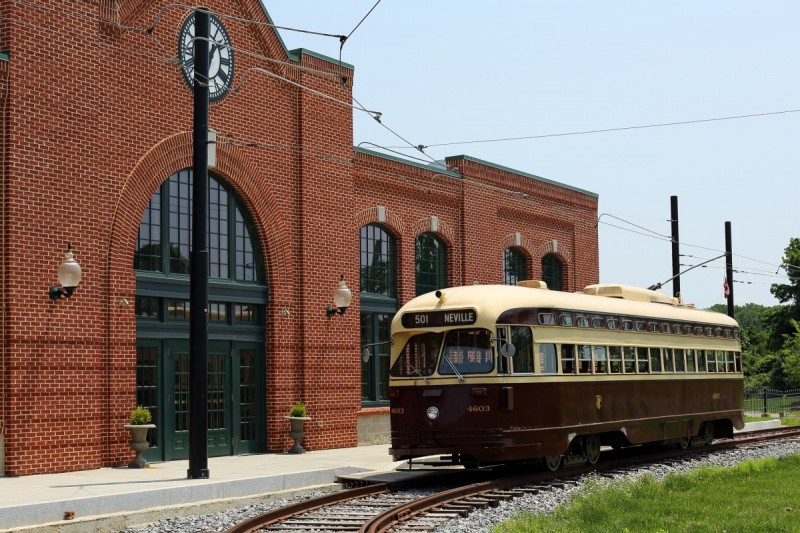3 great transportation museums in the Washington area you should visit

National Capital Trolley Museum. Image by Mr.TinDC licensed under Creative Commons.
If you’re interested in learning about the history of transportation, the DC area has a number of great transport-related museums. While they’re not as centrally-located as the museums on the National Mall, it’s pretty easy to reach them without a car.
Smithsonian National Air and Space Museum Steven F. Udvar-Hazy Center: Located in a hangar on the south end of Dulles Airport, this Air and Space location has room for incredible aircraft that would never fit in the Smithsonian’s museums on the Mall. Displays include the Space Shuttle Discovery, the prototype of the Boeing 707, a Concorde, captured Nazi Germany and Soviet military aircraft, and much more.
Visitors can also head to the top of an observation tower to observe Dulles flights land and take off. Even with these world-class exhibits, Smithsonian has implemented the same excellent admission price at Udvar-Hazy (free!) that it offers at its Mall museums.
To get there: First take the Silver Line to its Wiehle-Reston East terminus. Then, hop on Fairfax Connector Route 983, which runs every 20 minutes, pass the Dulles terminal, and stay on board until the museum stop at the end of the line. Fairfax County may want to look at adjusting the weekend schedule on this route: it spends a bit too long idling at its timepoints, ahead of a schedule that assumes exurban traffic congestion not present on the day I rode. But it is still a far better option than paying the $15 parking fee at the museum.
What else to do: On the way back to DC, Caboose Brewing is a fun place for a post-museum pint!
National Capital Trolley Museum: This museum, located in the Colesville area of eastern Montgomery County, is a bit more low key than any Smithsonian, open only from 12 to 5 pm on weekends. But it’s a must-visit for anyone interested in DC’s pre-WMATA transit history.
The museum has vintage streetcars from around the world on display (visitors must take a docent-led tour of the car barn), and operates them on a fully electrified outdoor track through the surrounding woods (rides are included with $7 museum admission). Interactive displays educate visitors on DC’s old streetcar routes, the last of which ceased operation in 1962.
To get there: Getting out to the museum is a bit of a haul from DC, but still can be easily done on transit – getting to a streetcar museum any other way simply wouldn’t feel right. From the Red Line, transfer to Ride On Route 26 (at Glenmont, Twinbrook, or White Flint) or Route 49 (at Glenmont or Rockville), exit at Bel Pre Road and Layhill Road, and walk eastbound for about 20 minutes.
For much of the walking route you will be trudging along on roadside grass, but at least the grass was cut the day I went! Biking from the bus stop might be faster, but also a bit unnerving and Capital Bikeshare is nowhere to be found this far out. After passing under the Intercounty Connector (for which the museum politely relocated its streetcar track to accommodate construction of the toll road), turn left and head up the driveway to the museum.
What else to do: A perfect follow-up to a trolley museum visit is taking a tour of or attending an event at Dupont Underground, an abandoned subterranean streetcar station (situated under Dupont Circle but above the Metro station) that now is home to an art space. But both the trolley museum and reimagined Dupont station, while fun to visit, serve as cautionary tales. The defunct transit system they memorialize could still be incredibly useful to DC residents today, serving as a vital first- and last-mile link to Metrorail.
Baltimore and Ohio Railroad Museum: Many historic railcars and locomotives are on display at this top-notch Baltimore facility, and an interesting exhibit shows the vital role rail transportation played during the Civil War. On Thursdays through Sundays, visitors can also take a 20 minute train ride along America’s first mile of commercial railroad. The only sobering thought: many of the old B&O railcars on display operated at speeds comparable to most American passenger trains today (with the exception of Northeast Corridor routes), demonstrating the need for investment in rail infrastructure. Admission to the museum is $18, plus an extra $3 for visitors wishing to ride the train.
To get there: MARC’s Camden Line offers the most direct access to the museum from DC. Simply ride along former B&O (now CSX) tracks to Camden Station at the end of the line, then head up to Pratt Street and the museum is a 10-15 minute walk westbound. Unfortunately, Camden Line service is currently limited to rush hour on weekdays. At other times, consider taking MARC’s Penn Line to West Baltimore station, head down the steps to the new transit center, and catch an Orange or Green CityLink bus on MTA’s recently realigned BaltimoreLink bus system. Hop off at Baltimore and Poppleton streets after a quick five minute ride, walk southbound on Poppleton for another five minutes, and you will be there.
What else to do: After your visit, you can walk over to Camden Yards to catch an Orioles game, or hop back on the Green CityLink and head up to Brewer’s Art, which offers excellent food and beer and is located just a few blocks from Baltimore Penn Station and its frequent DC-bound MARC and Amtrak trains. Baltimore Bike Share is also a useful option in central parts of the city, though membership reciprocity with Capital Bikeshare would certainly improve it.
